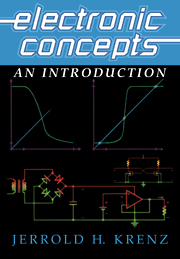Book contents
- Frontmatter
- Contents
- Preface
- 1 ELECTRONIC SYSTEMS: A CENTURY OF PROGRESS
- 2 THE SEMICONDUCTOR JUNCTION DIODE: THE BASIS OF MODERN ELECTRONICS
- 3 THE BIPOLAR JUNCTION TRANSISTOR: AN ACTIVE ELECTRONIC DEVICE
- 4 THE METAL-OXIDE FIELD-EFFECT TRANSISTOR: ANOTHER ACTIVE DEVICE
- 5 NEGATIVE FEEDBACK AND OPERATIONAL AMPLIFIERS
- 6 ELECTRONIC POWER SUPPLIES
- APPENDIX A FABRICATION OF INTEGRATED CIRCUITS
- APPENDIX B THE DESIGN PROCESS
- Index
APPENDIX A - FABRICATION OF INTEGRATED CIRCUITS
Published online by Cambridge University Press: 05 June 2012
- Frontmatter
- Contents
- Preface
- 1 ELECTRONIC SYSTEMS: A CENTURY OF PROGRESS
- 2 THE SEMICONDUCTOR JUNCTION DIODE: THE BASIS OF MODERN ELECTRONICS
- 3 THE BIPOLAR JUNCTION TRANSISTOR: AN ACTIVE ELECTRONIC DEVICE
- 4 THE METAL-OXIDE FIELD-EFFECT TRANSISTOR: ANOTHER ACTIVE DEVICE
- 5 NEGATIVE FEEDBACK AND OPERATIONAL AMPLIFIERS
- 6 ELECTRONIC POWER SUPPLIES
- APPENDIX A FABRICATION OF INTEGRATED CIRCUITS
- APPENDIX B THE DESIGN PROCESS
- Index
Summary
Modern electronic systems depend on the technology developed for fabricating integrated circuits. Integrated circuit technologies have achieved complexities unimaginable using discrete components and have made economical mass production possible. Electronic circuit design and integrated circuit fabrication require highly specialized, distinct areas of technological expertise. However, to produce optimal integrated circuits, it is necessary that the practitioners of these two technologies interact. The result of this joint effort has been a cornucopia of general purpose and specialized integrated circuits.
An understanding of physical and chemical processes utilizing high-vacuum techniques and high-temperature reactions is required for designing and fabricating integrated circuits. Moreover, the physical dimensions and tolerances of integrated circuit elements are much smaller than those utilized by more conventional engineering disciplines. Thus, the design and fabrication of integrated circuits is an extremely challenging endeavor.
Figure A.I provides a perspective on commonly used physical dimensions. For measurements associated with everyday activities, we tend to think in terms of either inches and feet or centimeters and meters, depending on our cultural background. For the elements of an integrated circuit, these are very large dimensions. On a logarithmic scale, integrated circuit dimensions, which are generally expressed in microns (µm, 10−6 m), tend to fall midway between the size of atoms and everyday measurements. Through conventional machining techniques, tolerances of 0.001 in., ≈25 µm, are not uncommon, whereas the smallest dimension of a typical machined item might be only 0.01 in., ≈0.25 mm.
- Type
- Chapter
- Information
- Electronic ConceptsAn Introduction, pp. 423 - 433Publisher: Cambridge University PressPrint publication year: 2000

